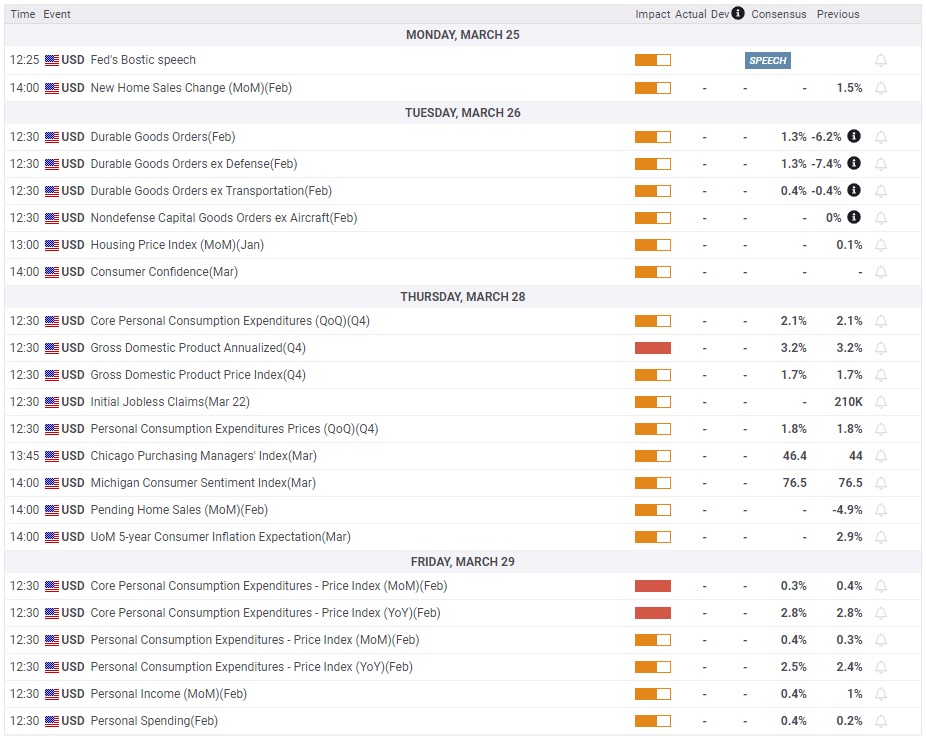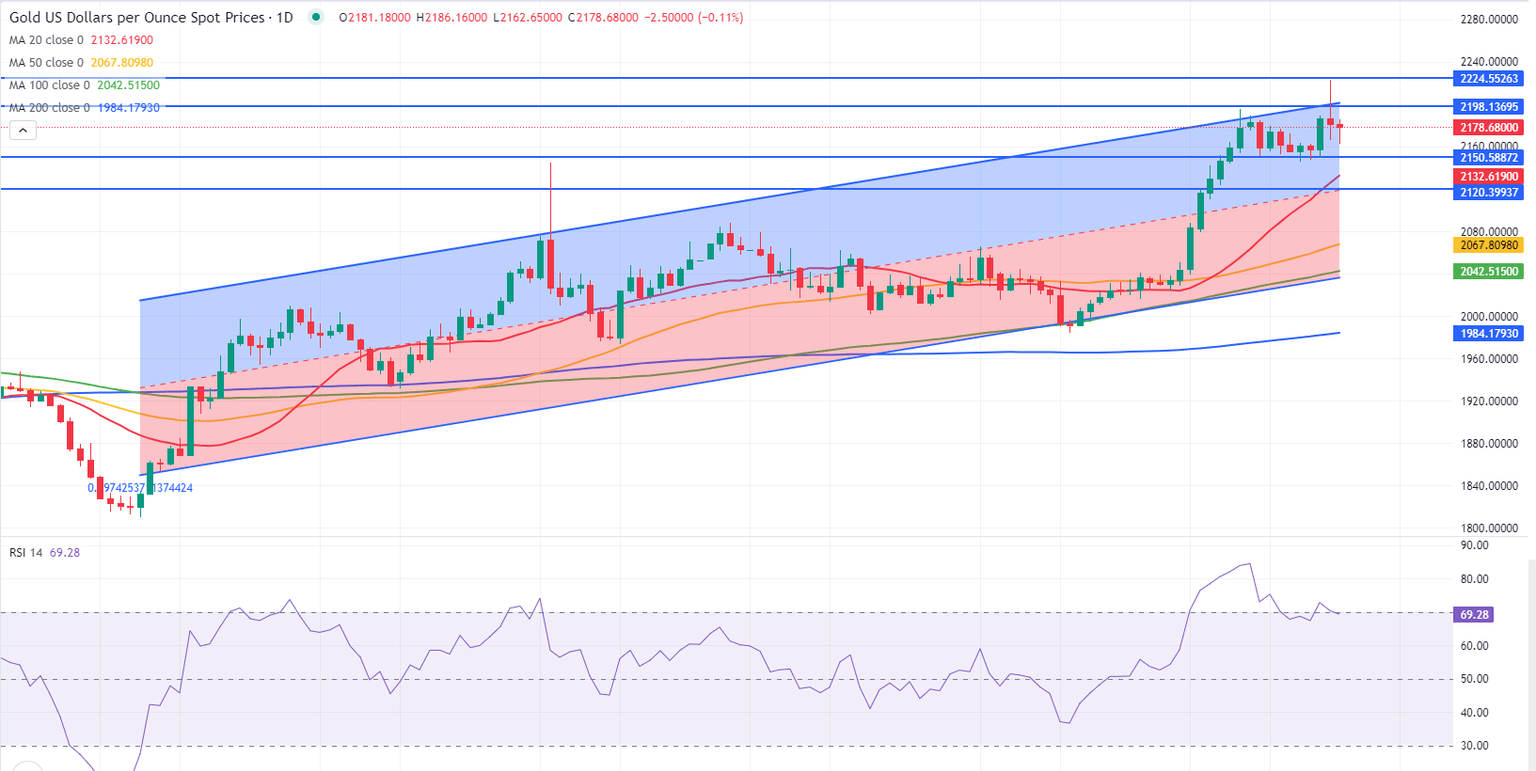Gold Weekly Forecast: XAU/USD set to test recent strength amid US Dollar rebound
- Gold staged a deep correction after reaching a fresh record high above $2,220.
- US PCE inflation data will be released on Easter Friday next week.
- XAU/USD technical outlook suggests that the bullish potential remains intact despite the latest pullback.

Gold turned south following a record-setting upsurge on Wednesday and erased the majority of its weekly gains, as the upbeat data releases from the US offset the negative impact of the Federal Reserve’s policy decisions on the US Dollar’s (USD) valuation.
Gold price made a sharp U-turn after touching new all-time high
Gold started the new week in a quiet manner as investors refrained from taking large positions ahead of the Federal Reserve’s (Fed) highly-anticipated March policy meeting. XAU/USD fluctuated between $2,150 and $2,160 on Monday and Tuesday, closing both days virtually unchanged.
The Fed announced on Wednesday that it left the policy rate unchanged at 5.25%-5.5% as forecast. The revised Summary of Projections (SEP), also known as the dot plot, showed that policymakers were still expecting to reduce the policy rate by 75 basis points in 2024, the same as they did in December. The initial reaction to the dot plot triggered a leg lower in the US Treasury bond yields and weighed on the US Dollar, with investors leaning toward a rate cut in June. The probability of the Fed leaving the policy rate unchanged in June declined to 25% from 40% before the Fed announcements.
In the post meeting press conference, Fed Chairman Jerome Powell adopted a relatively optimistic tone about the inflation outlook and forced the USD to stay under bearish pressure. Powell acknowledged that inflation numbers were "quite high" in January and February but noted that they have not changed the overall story on disinflation, arguing that they were higher due to seasonal effects.
As the USD sell-off picked up steam during the Asian trading hours on Thursday, XAU/USD extended its rally and reached a fresh new all-time high above $2,220. Later in the day, however, upbeat macroeconomic data releases from the US helped the USD rebound decisively and forced Gold to retreat back below $2,200.
The number of first-time applications for unemployment benefits declined to 210,000 in the week ending March 16, the US Department of Labor reported. Additionally, S&P Global Composite PMI came in at 52.2 in March’s flash estimate, suggesting that the business activity in the private sector continued to expand at a healthy pace. Assessing the PMI surveys’ findings, “a steepening rise in costs, combined with strengthened pricing power amid the recent upturn in demand, meant inflationary pressures gathered pace again in March,” said Chris Williamson, Chief Business Economist at S&P Global Market Intelligence.
Meanwhile, the Swiss National Bank’s (SNB) unexpected decision to lower the policy rate by 25 basis points and the Bank of England’s (BoE) policy announcements triggered capital outflows out of Pound Sterling and Swiss Franc, providing an additional boost to the USD on Thursday. Two members of the BoE’s Monetary Policy Committee (MPC), Jonathan Haskel and Catherine Mann, voted in favor of a hold after voting for a 25 bps hike in the previous meeting, while Swati Dhingra continued to vote for a 25 bps cut.
The broad-based USD strength forces XAU/USD to stay on the back foot ahead of the weekend but the pair managed to erase a portion of its daily losses as the 10-year US yield edged lower.
Gold price could have a delayed reaction to US PCE inflation data
The US economic docket will feature Durable Goods Orders data for February and the Conference Board’s Consumer Confidence Index for March on Tuesday. On Thursday, the US Bureau of Economic Analysis (BEA) will release the final revision to the fourth-quarter Gross Domestic Product (GDP) and publish the Personal Consumption Expenditures (PCE) Price Index data for February on Friday.
Markets expect the annualized fourth-quarter GDP growth to be confirmed at 3.2%. The market reaction to the GDP data could be straightforward and remain short-lived. An upward revision is likely to support the USD and weigh on XAU/USD, while a downward revision could weigh on the currency.
Although the PCE Price Index is usually watched closely by market participants, the trading action is likely to remain subdued on Friday with stock and bond markets remaining closed in observance of the Good Friday holiday. Hence, a delayed reaction could be witnessed at the weekly opening on Monday. A stronger-than-expected increase in the monthly Core PCE Price Index could support the USD at the beginning of next week. On the other hand, a print below the market consensus of 0.3% could help Gold gain traction.
Gold technical outlook
The Relative Strength Index (RSI) indicator on the daily chart retreated below 70 but managed to hold above 60, suggesting that Gold’s bullish bias remains intact after correcting overbought conditions. Additionally, XAU/USD remains within the ascending regression channel coming from October.
On the downside, interim support seems to have formed at $2,150 (static level) before $2,130-$2,120, where the 20-day Simple Moving Average (SMA) and the mid-point of the ascending channel are located.
First resistance aligns at $2,185 (static level) before $2,200 (upper-limit of the ascending channel) and $2,223 (all-time high).
Gold FAQs
Gold has played a key role in human’s history as it has been widely used as a store of value and medium of exchange. Currently, apart from its shine and usage for jewelry, the precious metal is widely seen as a safe-haven asset, meaning that it is considered a good investment during turbulent times. Gold is also widely seen as a hedge against inflation and against depreciating currencies as it doesn’t rely on any specific issuer or government.
Central banks are the biggest Gold holders. In their aim to support their currencies in turbulent times, central banks tend to diversify their reserves and buy Gold to improve the perceived strength of the economy and the currency. High Gold reserves can be a source of trust for a country’s solvency. Central banks added 1,136 tonnes of Gold worth around $70 billion to their reserves in 2022, according to data from the World Gold Council. This is the highest yearly purchase since records began. Central banks from emerging economies such as China, India and Turkey are quickly increasing their Gold reserves.
Gold has an inverse correlation with the US Dollar and US Treasuries, which are both major reserve and safe-haven assets. When the Dollar depreciates, Gold tends to rise, enabling investors and central banks to diversify their assets in turbulent times. Gold is also inversely correlated with risk assets. A rally in the stock market tends to weaken Gold price, while sell-offs in riskier markets tend to favor the precious metal.
The price can move due to a wide range of factors. Geopolitical instability or fears of a deep recession can quickly make Gold price escalate due to its safe-haven status. As a yield-less asset, Gold tends to rise with lower interest rates, while higher cost of money usually weighs down on the yellow metal. Still, most moves depend on how the US Dollar (USD) behaves as the asset is priced in dollars (XAU/USD). A strong Dollar tends to keep the price of Gold controlled, whereas a weaker Dollar is likely to push Gold prices up.
Premium
You have reached your limit of 3 free articles for this month.
Start your subscription and get access to all our original articles.
Author

Eren Sengezer
FXStreet
As an economist at heart, Eren Sengezer specializes in the assessment of the short-term and long-term impacts of macroeconomic data, central bank policies and political developments on financial assets.



















